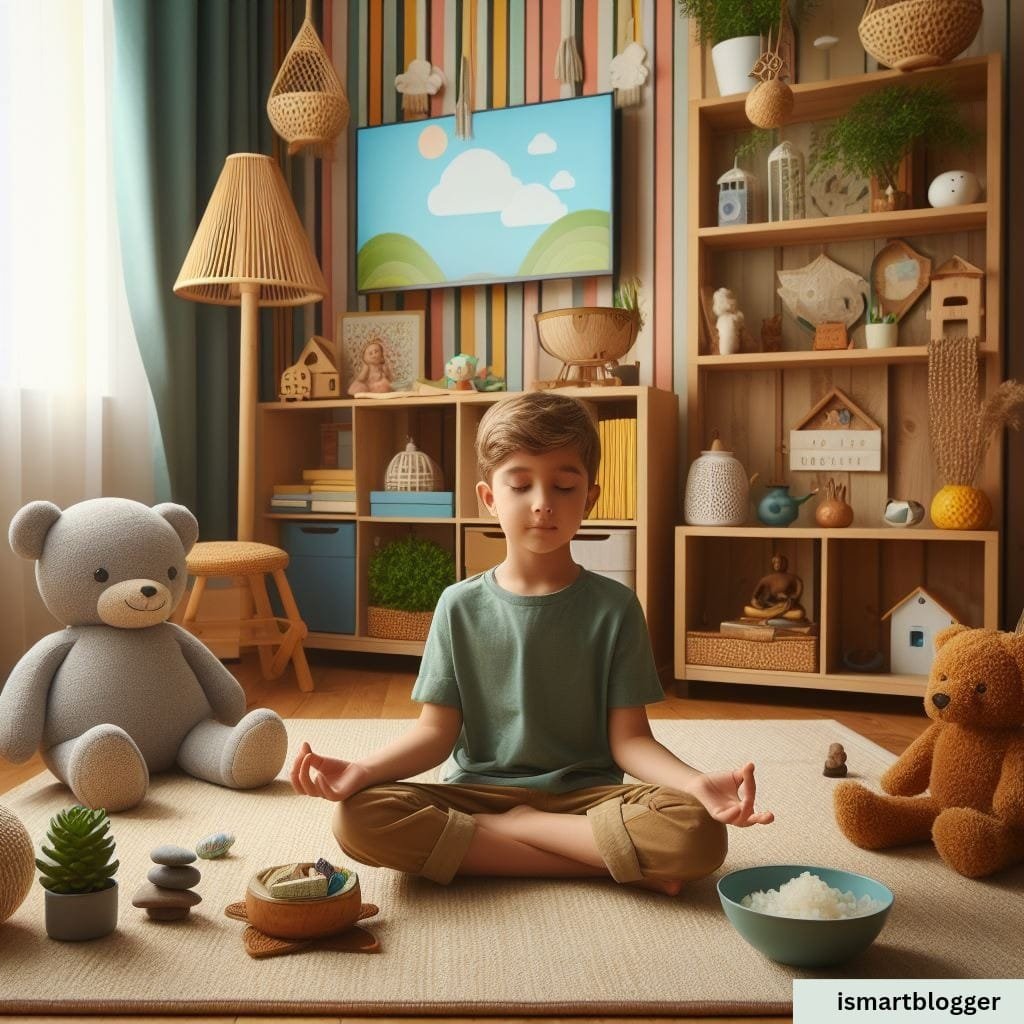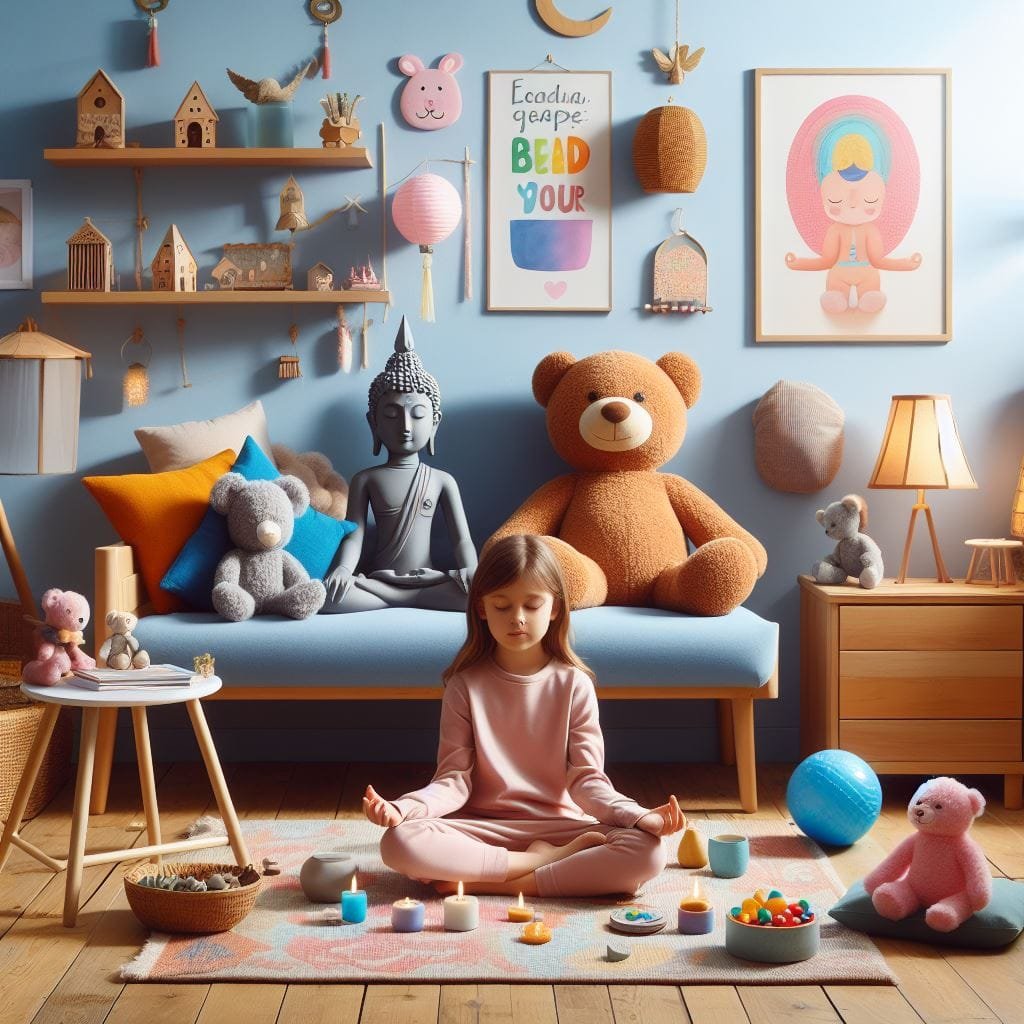Introduction
Children today face an increasingly fast-paced and demanding world, leading to elevated levels of stress and anxiety. As parents, it is essential to provide them with the tools they need to navigate these challenges and cultivate emotional well-being.
One such tool that has gained recognition for its effectiveness is meditation. Meditation offers children a sanctuary of stillness in the midst of chaos, allowing them to develop essential life skills such as self-awareness, focus, and emotional regulation.
Brief Explanation of the Importance of Meditation for Children’s Well-being
Meditation is not solely reserved for adults seeking inner peace; it can also greatly benefit children. By engaging in regular meditation practices, children can learn to connect with their inner selves and develop a deep sense of calm.
Research has shown that meditation helps promote mental clarity, reduce stress levels, improve sleep quality, enhance concentration abilities, boost self-esteem, and increase overall happiness. Moreover, meditation equips children with invaluable coping mechanisms to navigate through various emotional states effectively.
By fostering a greater understanding of their own thoughts and emotions through mindfulness practices, children gain resilience when dealing with challenging situations like peer pressure or academic stress. In this way, meditation empowers children by providing them with practical tools they can use throughout their lives.
Overview of the Benefits of Creating a Dedicated Meditation Space at Home
While mindfulness can be practiced anywhere at any time, having a dedicated space for meditation at home offers numerous advantages for children’s well-being. The creation of a kid-friendly meditation space provides an opportunity for intentional practice in an environment specially designed to foster relaxation and focus. By designating a specific area solely for meditation purposes within the home setting, you establish a consistent reminder that encourages regular practice.
This dedicated space serves as a physical manifestation of your commitment to prioritizing your child’s mental health and provides them with an inviting sanctuary where they can retreat to find balance and tranquility amidst the hustle and bustle of daily life. Furthermore, having a dedicated meditation space nurtures a sense of ownership and personal connection for children.
They can engage in the process of designing and customizing this space according to their preferences, fostering a sense of creativity and self-expression. This unique environment becomes a safe haven where children feel comfortable exploring their inner selves, thus deepening their meditation experience.
In the following sections, we will explore practical steps to create an optimal kid-friendly meditation space at home. From selecting the right location to incorporating stimulating elements, we will guide you through the process of crafting an inviting haven that will inspire your child’s mindfulness journey.
Setting the Stage: Choosing the Right Location
Consideration of a quiet and peaceful area in the house
When creating a kid-friendly meditation space at home, it is crucial to select a location that offers tranquility and serenity. Find an area in your house where distractions are minimal, such as away from TVs, bustling hallways, or noisy appliances.
A quiet corner or unused room can serve as an ideal spot for creating an environment conducive to mindfulness practice. This allows children to focus their attention inward without external disturbances.
In addition to avoiding noise disruptions, it is important to consider the overall ambiance of the chosen location. A serene atmosphere can be achieved by selecting a space that fosters a sense of calmness and relaxation.
Consider using natural materials like wood or bamboo for furniture or decor elements as they can bring an organic and grounding to feel to the space. The absence of clutter is also crucial in creating a serene environment, as it helps reduce visual distractions that may hinder concentration.
Importance of natural light and fresh air in the chosen space
Natural light has a profound impact on our mood and well-being, making it essential for any meditation space. Look for a location that receives ample sunlight throughout the day, preferably with large windows or skylights that allow rays of sunshine to flood into the space. Sunlight not only enhances mood but also provides necessary vitamin D which supports healthy brain function.
Fresh air circulation is equally significant when designing your kid-friendly meditation space at home. Choose an area with good ventilation to ensure proper airflow during meditation sessions.
Open windows whenever possible or use air purifiers if needed, as clean air helps promote feelings of clarity and rejuvenation. Remember, choosing the right location for your child’s meditation space sets the foundation for their practice by providing an environment free from external disturbances while embracing natural elements that contribute to their overall well-being.
Creating a Calming Atmosphere: Colors, Scents, and Sounds
Use of Soft, Soothing Colors on Walls and Decor
When designing a kid-friendly meditation space at home, the choice of colors plays a crucial role in creating a calming atmosphere. Opting for soft, soothing colors like pastels or light shades of blue, green, or lavender can help instill a sense of tranquility and relaxation. These gentle hues have been found to have a positive impact on mood while promoting feelings of serenity.
Consider painting the walls in one of these calming colors to set the tone for the meditation space. Additionally, choose decor items that align with the chosen color scheme to create visual harmony within the space.
Incorporation of Gentle Scents like Lavender or Chamomile through Candles or Essential Oils Diffusers
Introducing gentle scents into your kid-friendly meditation space can enhance relaxation and create an immersive sensory experience for children. Aromatherapy has long been recognized as a powerful tool for promoting calmness and reducing anxiety. Lavender and chamomile are particularly well-known for their soothing properties and are safe choices when it comes to children’s well-being.
Use scented candles with these fragrances or consider using an essential oils diffuser to disperse these calming scents throughout the room. Remember to use child-safe essential oils and ensure proper ventilation if using candles.
Introduction to Relaxing Sounds such as Nature Sounds or Instrumental Music
Beyond visual elements, auditory cues also play an integral role in cultivating tranquility within a kid-friendly meditation space. Incorporating relaxing sounds can help mask distractions from outside noises while inducing a peaceful ambiance conducive to meditation practice.
Nature sounds like flowing water, gentle rainstorms, or birds chirping provide natural harmony that resonates with our innate connection to the environment. Alternatively, instrumental music with soothing melodies, such as soft piano or gentle strings, can create a serene soundscape.
Experiment with different sound options to find what resonates best with your child’s preferences and helps them enter a state of deep relaxation during their meditation sessions. When creating a kid-friendly meditation space at home, it is essential to pay attention to the colors, scents, and sounds within the environment.
Soft, soothing colors on the walls and decor can create a visually calming atmosphere. Incorporating gentle scents like lavender or chamomile through candles or essential oil diffusers can enhance relaxation and promote a sense of tranquility.
Introducing relaxing sounds such as nature sounds or instrumental music provides auditory cues that aid in achieving a peaceful state of mind during meditation practice. By carefully curating these elements in your kid-friendly meditation space, you provide an environment conducive to mindfulness and well-being for your child.
Comfortable Seating Options for Little Meditators
When creating a kid-friendly meditation space, it is crucial to prioritize comfort to help children fully immerse themselves in the practice. Choosing appropriate seating options can make a significant difference in supporting their relaxation and focus.
One excellent choice is age-appropriate cushions or bean bags. These soft and pliable seating options provide a cozy and relaxed posture for young meditators.
Opt for cushions with removable covers, allowing easy cleaning and customization with fun patterns or colors that resonate with your child’s preferences. In addition to cushions, introducing kid-sized meditation chairs or mats can enhance the comfort level further.
Kid-sized chairs offer back support and are specifically designed to promote proper alignment during meditation sessions. Look out for chairs made of breathable materials such as bamboo or cotton that provide optimal air circulation, ensuring your child stays cool and comfortable throughout their practice.
To prevent discomfort during longer meditation sessions, it is vital to emphasize the importance of providing back support. A well-supported back encourages better posture and prevents strain on muscles.
Consider using cushions or pillows strategically placed against a wall or stacked behind the child’s back while they sit cross-legged on a cushion or chair. This arrangement ensures proper spinal alignment, reducing the risk of discomfort or distraction during extended periods of meditation.
Engaging Visuals: Inspiring Wall Art and Decorations

Displaying calming images like nature scenes or inspirational quotes
Creating a visually appealing meditation space for kids involves selecting artwork that invokes a sense of tranquility and inspiration. Displaying calming images, such as serene nature scenes or gentle landscapes, can help create a peaceful atmosphere conducive to meditation. Pictures of beautiful sunsets, rolling hills, or lush forests can transport young minds to a tranquil state of being.
These images not only provide visual stimulation but also serve as a reminder of the beauty and serenity found in nature. Alongside soothing imagery, incorporating inspirational quotes can foster positivity and encourage personal growth.
Simple yet profound phrases like “Breathe in peace, breathe out love” or “Be kind to yourself and others” can empower children with mindful mantras during their meditation practice. Placing these quotes strategically throughout the meditation space will serve as gentle reminders of mindfulness principles while infusing the environment with positive energy.
Encouraging creativity by allowing children to create their own artwork for display
Empowering children to express themselves through art is an essential aspect of creating a kid-friendly meditation space. Encourage your little ones to unleash their creativity by providing art supplies such as colored pencils, markers, or watercolors. Let them freely explore their imagination and create artwork that resonates with them personally.
Once completed, prominently display their masterpieces within the meditation space. By showcasing children’s own creations, they will feel proud of their work and develop a sense of ownership over the environment.
This fosters a deeper connection to the space and encourages them to embrace mindfulness as an integral part of their lives. To take it further, you can organize regular art sessions where kids can engage in guided art activities that promote self-expression and mindfulness simultaneously.
These sessions could involve painting mandalas or creating vision boards that reflect their aspirations and dreams. By involving children in the process of decorating their meditation space, you are cultivating a sense of ownership, creativity, and self-awareness.
Incorporating engaging visuals in a kid-friendly meditation space can significantly enhance the experience for young meditators. Displaying calming images and inspirational quotes creates a serene atmosphere that encourages relaxation and reflection.
Additionally, allowing children to create their own artwork fosters creativity and empowers them to take ownership of their meditation space. By infusing the environment with visually appealing elements, you are providing a nurturing space for your children to explore mindfulness and develop a lifelong habit of self-reflection and inner peace.
Mindful Props: Tools to Enhance Meditation Experience
Introduction to sensory items like stress balls, fidget spinners, or textured objects for tactile stimulation
When creating a kid-friendly meditation space, it is essential to incorporate sensory items that engage the sense of touch. Sensory tools like stress balls or fidget spinners can provide a tactile experience that helps children focus their attention and release any built-up tension.
These small handheld objects offer an outlet for restless energy, allowing children to redirect their focus inward during meditation sessions. By holding and manipulating these items, children can experience the comforting sensation of different textures against their skin.
To further enhance tactile stimulation, consider introducing textured objects within the meditation space. These could include soft fabric squares with different textures such as silk, velvet, or faux fur.
Children can explore the various sensations by running their fingers over these surfaces while engaging in meditation. The tactile experience not only adds an element of interest but also promotes grounding and mindfulness through touch awareness.
Useful tools such as singing bowls, chimes, or Tibetan prayer flags to enhance focus and relaxation
In addition to sensory items, incorporating mindful props that create soothing sounds can greatly enhance the meditation experience for children. Singing bowls are excellent tools that produce resonating tones when struck gently with a mallet or played by running a wooden stick along its rim.
The harmonic vibrations emitted by singing bowls have a calming effect on both mind and body. Encouraging children to listen attentively to these enchanting sounds creates an opportunity for them to cultivate deep relaxation and inner tranquility.
Chimes are another valuable addition to the kid-friendly meditation space as they produce beautiful melodic tones when touched or swayed gently by air currents in the room. Their gentle tinkling acts as a gentle reminder for young meditators to stay present in their practice.
Tibetan prayer flags can serve as visual and auditory cues during meditation. These colorful flags, imprinted with sacred symbols and mantras, flutter in the breeze, creating a serene environment.
The soft rustling sound they make can act as a gentle backdrop that helps children maintain focus while cultivating a sense of peace and serenity. By incorporating these useful tools within the meditation space, children will have additional resources at their disposal to deepen their mindfulness practice and create a more immersive experience that nurtures their well-being.
Teaching Mindfulness Techniques: Guided Meditation Resources
Finding Age-Appropriate Guided Meditation Apps or Websites
When it comes to teaching mindfulness techniques to children, guided meditations can be incredibly beneficial. They provide a structured framework that helps children focus their attention and engage with the practice.
Fortunately, there are numerous age-appropriate guided meditation apps and websites available that cater specifically to children’s needs. One highly recommended app is “Calm Kids” which offers a variety of guided meditations designed for different age groups.
It features soothing narration, calming background music, and simple visualizations tailored to engage children in their unique way. Another excellent option is “Smiling Mind,” an app developed by psychologists and educators that provides mindfulness programs for various age ranges, including specific modules for classroom use.
In addition to apps, websites like “Headspace for Kids” provide guided meditations specifically designed for younger audiences. This platform incorporates engaging animations and storytelling elements into its meditation sessions to capture children’s imaginations while teaching them valuable mindfulness skills.
Incorporating Storytelling into Guided Meditations
Storytelling can be a powerful tool when introducing younger children to guided meditations. By incorporating narratives into these sessions, we create an enjoyable and immersive experience that enhances their engagement and understanding of mindfulness practices.
For example, during a meditation session focused on gratitude, you could guide children through visualizing themselves in a magical forest where they encounter friendly animals who represent different things they are grateful for. Through storytelling elements like this, children can easily grasp abstract concepts while also developing their creativity and imagination.
Encouraging parents or guardians to join these storytelling meditation sessions with their children can further foster connection and bonding within the family unit. By embodying characters or taking turns adding details to the story, adults can actively participate in the child’s mindfulness journey and create a supportive environment for them to explore their emotions and thoughts.
Conclusion
Creating a kid-friendly meditation space at home is an invaluable investment in your child’s well-being and personal growth. By providing a dedicated area that caters to their needs, utilizing age-appropriate guided meditation resources, and incorporating storytelling into their mindfulness practice, you are nurturing their ability to find peace, focus, and resilience in today’s fast-paced world.
Remember that building a meditation space is not just about the physical environment; it is about cultivating an atmosphere of calmness, creativity, and connection. Encourage your little ones to embrace mindfulness techniques as tools for self-care and self-discovery. Instilling these practices early on can empower them with lifelong skills that promote mental clarity, emotional intelligence, and overall contentment. So go forth with confidence as you create a serene sanctuary where your child can embark on an enriching journey of self-awareness and inner peace.





